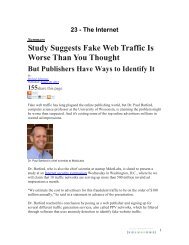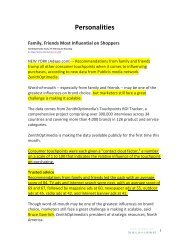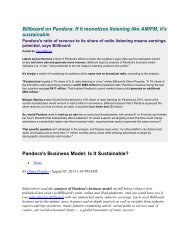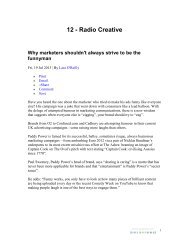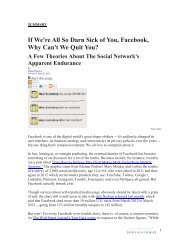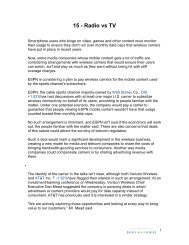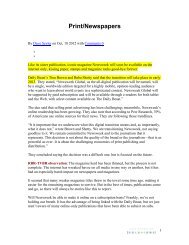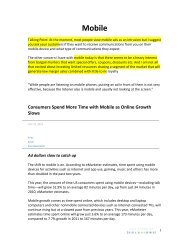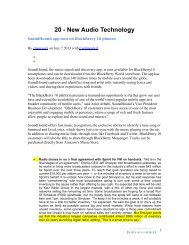Mobile - Katz Marketing Solutions | Radio Advertising | Media Agency
Mobile - Katz Marketing Solutions | Radio Advertising | Media Agency
Mobile - Katz Marketing Solutions | Radio Advertising | Media Agency
Create successful ePaper yourself
Turn your PDF publications into a flip-book with our unique Google optimized e-Paper software.
Location is a big deal. For the history of digital advertising we‘ve basically been targeting on a few things, like content, cookie data and search. Thebig new data set mobile brings to the table is location—a data set that can be as important at inferring intent, demographics, audience segments andother attributes as any we have seen to date.And it brings genuine value to end users—helping them find products and services where and when they want them—a key attribute of the mostvaluable advertising mediums.There is a lot of energy and excitement around location targeting in mobile—from agencies and brands that see the enormous potential and fromtechnology companies that are building the next-generation platforms for harvesting and leveraging this data for marketing and advertising.But there‘s one very significant problem that is holding mobile location targeting back—the market has been flooded with bad location data. And manyare turning a blind eye to this fact because to acknowledge it would be contrary to their business interests.There are many sources for actionable mobile location data. The device can share GPS level data (provided the user has opted in to share locationwith an app or web site). This GPS data is typically represented by latitude and longitude coordinates (lat/long) and is generally very accurate. Thenetwork can share data derived from cell tower triangulation which is also quite accurate. There is also user-supplied location data (e.g. when a userprovides his zip code when registering for a site or service).Another method of deriving location is IP address analysis, which can range from very accurate to completely inaccurate. An IP lookup can resolve toa terrestrial wifi network (like an airport or coffee shop), most of which are well indexed to location. But an IP lookup can also resolve to a carrier IPaddress and carrier IPs vary widely in accuracy. Many carrier IP locations are accurate to the metro or zip level, but many resolve to ―backhaul‖addresses—which are the locations where the carrier aggregates mobile data for transport over fiber trunks in the telecommunication infrastructure—which are generally inaccurate.The crème of the crop in location data targeting is device-level GPS lat/long data. Highly targeted mobile advertising campaigns that are focused ontargeting people in an area the size of a city block or a shopping center or a big box store require this precise lat/long data (and potentially wifi data).The problem is that lat/long data is very scarce. Most industry experts consistently estimate that about 5-10% of mobile ad impressions have lat/longfrom users who have opted in to share location with an app or site. This makes sense. Most apps and many of the largest mobile consumer apps—like internet radio or game apps—aren‘t allowed by Apple to ask for location.One of the rules for app store approval is that, if the developer of an app has built in a feature that asks the user for location, he must have a goodreason for doing so—location-based apps like Foursquare, mapping apps or local media properties sites/apps that are providing geo-aware weather,sports scores or movie times are good examples of apps that can ask for location and with which users tend to share location.Yet, some exchanges and networks claim 70, 80 or even 100 percent lat/long impressions. How can this be? One more time—5 to 10% of all mobileimpressions have lat/long but a given exchange may claim 80% lat/long?The answer is some people are making up lat/longs. This is the dirty little secret of location-based advertising. About 12 months ago, some publishersfigured out that location was the one attribute that really moved the needle in the exchanges and the ―inferred‖ (read ―made up‖) lat/long was born. 1If buyers are paying a premium for lat/long location data and it‘s the only thing that can give a publisher‘s mobile impressions a price boost,manipulators will find a way. And they have. In 12 months‘ time, the number of lat/long impressions in exchanges has grown from the industry average5-10% to the current 70-80%. Even though, generally speaking, lower quality, rather than premium impressions, end up in exchanges, so one wouldexpect that premium lat/long impressions would be used by publishers and their location specialist partners and fewer (not more) lat/long impressionswould be making it into the exchanges.The methods being used to generate ―inferred‖ lat/longs fall into two primary categories (although there are more): ―centroids‖ or ―randomized‖ lat/longs.Centroids are lat/long coordinates that are generated by software programs that automatically pick the center of a geographic region as a substitutefor either no location data —many corrupt lat/longs are dead center in the middle of the country—or for lesser-quality location data—they are in themiddle of a state, DMA, city or zip.Randomized lat/longs are generated by software programs that randomly choose lat/longs within a region. This is a really big problem for the evolutionof the highly granular location targeting that has so much potential and has marketers so excited. If a marketer is targeting a particular store location,mall or office building, a particular neighborhood or city block or an audience segment that is based on inferences drawn from the context of a user‘slocation, then bogus location coordinates are almost certainly targeting the wrong place and the wrong people and driving down performance.Garbage in, garbage out.So what to do about it? At Verve, our roots are in building mobile tools for publishers and we work with many of the largest premium contentpublishers in the US providing them with a mobile publishing, web and app platform that powers their mobile content distribution.So, for about a third of the publishers we work with, we are the first party technology platform —we know with 100% certainty what location the GPSchip in the device is generating. Also, most of these properties are location-aware, giving users good reason to opt in to sharing location.Further, for the publishers we work with who aren‘t on our publishing platform, we work with most of them directly, through first party businessdevelopment relationships. If we see data that our systems detect as suspect we call them up and rectify the situation—either they send us good dataor we don‘t work with them. When we do venture into the mobile exchanges we leverage our unique proprietary technology that allows us to recognizeand parse ad impressions with genuine location data from those with false location data and cherry pick verified impressions.78



